A 15 Minute Comprehensive Guide To Software Development

Software development has gained momentum in recent years. Organizations are capitalizing on the power of software applications for boosting their digital strategies and improving profitability and productivity. To develop a good software application, you need the knowledge of the systematic flow that the development process follows, along with all minute elements that are directly and indirectly related to it.
Based on our experience, we have built a comprehensive guide to software development. Go through this software development guide to know what it takes to develop a software application.
This guide to software development provides detailed information about software development definition, types of software, steps in the software development process, tools, solutions, and best practices for software development. By the end of this detailed software development guide, you would have a solid foundation built to proceed with the next step of your software development goals.
What is Software Development?
Software development is defined as the process of ideating, designing, developing, deploying, and maintaining software or its components. Building a software involves a number of planned activities which are properly structured and performed in phases called Software Development Lifecycle (SDLC).
When one talks about software development, it doesn’t necessarily mean writing codes. It means being part of any activity from ideation to final deployment of the software, as the software development process also includes research, prototyping, updation, modification, optimization, maintenance, or associated activities that result in the envisioned software.
Different types of software development strategies are there and you should choose the one that best suits your problem.
Types of Software
Having discussed software development, now let’s move to understanding various types of software. Software applications are constantly evolving and so are their types. Majorly, we have 5 types of software applications, which we are going to discuss in detail below. Remember, each type is built for a specific purpose and so, you need different types of software developers who are expert in given niches of software.

System software
System software refers to software type that supports the core functions of computer hardware and software programs. System Software acts as the bridge between application software and hardware.
These types of software tell the application software and the hardware peripheral device what functions it needs to perform when the user interacts with the application software installed on operating systems such as Android, iOS, Windows, or Linux.
Interestingly, an operating system in itself is a system software. Besides, middleware which lies between the operating system and the application, namely application server, database, and transaction processing monitors, and utilities software, for example, disk management tools, antivirus software, and compression tools belong to the category of system software.
Middleware
Middleware is a kind of software application that acts as an interface between distributed applications and the operating system. So apart from those applications that the operating system provides, middleware applications create a link between the two diverse components. Middleware applications have played a major role in the evolution of distributed environments like cloud computing.
There are various types of middleware applications such as transaction middleware, database middleware, and message oriented middleware. Each of these middleware applications perform a special function. For instance, transaction middleware manages client-server transactions. Database middleware ensures communication with the database, while message-oriented middleware handles asynchronous communication.
Application Software
Application software is a complete package of software for end users or other users. Application software is generally task or domain specific. For instance, ecommerce applications for shopping, game apps for entertainment, networking sites for connecting and sharing with people, and productivity suites for monitoring and tracking.
Uber, QuickBooks, Zoom, Snapchat, Twitter, Amazon, and several other similar applications that you come across in your daily life are examples of application software.
Programming Software
Programming software includes a set of computer programs designed to enable software developers to write, develop, debug, and maintain software. A few examples of programming software are source code editors, assemblers, compilers, and interpreters.
Software developers usually refer to these programming software as software development tools. There are tools for mobile app development as well that we have covered separately. The reference represents the use of software to accomplish specific tasks and is used on an ad-hoc basis and not because of any distinguished feature of the tool, as the tools are also computer programs and thus software.
For example, IDE is a programming software that consists of a code editor and debugger, often referred to as tools. The code editor or debuggers are also available as standalone applications, which means they are not just a part of a large programming software but are programming software in themselves.
Driver Software
Driver software provides a programming interface to let devices and operating systems interact with each other. It enables the user to utilize the functionality of the peripherals properly in every respective way. Driver software is designed to call the operating system and introduce the user to the properties and user interface, through which the peripherals can be used.
Nowadays, there are many devices work-on plug-n-play feature, which enables the user to directly use the device without installing the driver(for that dedicated device) manually. But in earlier days, even USB Flash Drives needed the CD to install the drivers for them. The two examples of driver software: one having P-n-P and the other without it are:
Example1: suppose a USB Flash Drive is inserted into the USB Port in the computer. Now what’s happening inside the system is that on inserting the USB, it sends the interrupt signal to the CPU, to tell it that it needs attention. Then, the CPU will send the data signal through the data bus to search for any interface that might be useful for it to interact with the Operating System. This interface that the CPU searches for, is called Driver. In today’s USB(s) these drivers are already stored in their Read Only memory(ROM), which gets installed automatically just after the CPU finds out that there is an interface present, and it executes and installs the driver successfully.
Example2: Printers are the best example for non P-n-P devices because they need Drivers to be installed manually. These drivers can be downloaded from the OEM (Original Equipment Manufacturer). Sometimes the OEM drivers don’t work due to incompatibility with Hardware/OS, then third party Drivers come into play, which can be downloaded from particular websites.
Although it is a type of System Software, we have mentioned it separately because it facilitates communication between a computer and an external device.
Embedded Software
Embedded system software is a set of computer programs written only to be run on specific hardware to help it control and manage certain functions. Embedded Software could be essayed as a software that when embedded with particular hardware, performs a certain function. Although Embedded software is a wide branch in itself, on a cell level, it is known as Firmware, which is designed for a specific purpose only.
These Firmware programs are boiled down to a hardware called Integrated Circuit (IC) which then gets mounted on the Board with engraved circuits, which is commonly known as the Motherboard. All these parts (i.e. Motherboard, IC, Firmware, and other electronic components) when functioning together, produce a favorable result.
There are various programming languages used for the development of Embedded Systems. Some of them are C language (known as Embedded C), C++, Embedded C++, Python, mPython (also known as Micro Python), Java, Rust, and others which can be embedded with hardware to attain output.
Nowadays, System On Chip (SOC) is also very popular among developers. SOCs are actually mini motherboards with mounted hardwares and having the functionality of a computer. Popularly used SOC(s) are Arduino, RaspberryPi, BananaPi, and other similar variants, which are available in various specifications.
These 5 types of software applications mostly contribute to the entire IT infrastructure around us. While software applications make our life easier, building these applications is hard in the sense that the process of software development demands more than just technical skills.
As it is not just the process but also the approach to the software development process which plays an important role in successful development. And directly jumping into the SLDC definitely is not the right approach. There are several undocumented stages to ensure better preparation, of which the first is to identify the objective of the software, to be specific—why is it important to develop software? Though the obvious answer is yes to meet your needs; however, you need to zero in on the specific requirements to develop the best software application. Moreover, different kinds of software development strategies exist, and you need to carefully analyze multiple factors to choose the one that would be apt for your project.
What is the Objective of Software Development
Objective of software development
It is software development project types that dictate objectives in software development. Identifying the objective of software development is necessary to remain focused and avoid ambiguity throughout the development process. Why is the software being built? What would the software look like when developed? What problem does the software solve? You must consider all these questions surrounding your objectives to successfully accomplish your software development projects.
These and several other follow-up questions would help bring clarity to the software development goals. A definite answer to these questions would keep everyone in the software development team on the same page and help the team sort out differences or miscommunications quickly.
Clearly-defined objectives offer a clear idea of the resources needed in software development projects. Objectives thus play an important role in project planning.
As there are multiple categories of software development projects, objectives will be affected by the category to which your project would belong. So, the objectives of custom software development will differ from those of COTS and will be a decisive factor in what type of custom software development services you need. Anyway, in general, software development objectives are characterized by the following features.
Key features of software development objective
A well-defined objective has the following features:
- Well-defined: What will be accomplished with the software? What would it do?
- Measurable: Can the efforts be quantified? Can the progress be tracked?
- Attainable: How the goal of software development would be achieved? Who will be doing what? Is everyone involved fully informed about their role in the development process?
- Realistic: Is the goal realistic? Does the envisioned software have a sustainable future? Are the time and budget dedicated to the software development project relevant?
- Time-bound: How long does software development take? Can the entire process be split into specific time-bound tasks?
The answer to these questions must be straightforward and explainable. Ambiguous components must not be left in the hope of getting resolved on their own with time or to be addressed at a later stage to save time today. Besides, everyone in the software development team should have the same layout of the objectives to mitigate the risk of any team member going off track at any point during development.
Who are in Software Development Team
The first thing that comes to mind when talking about a software development team is software developers. Mostly they are associated with writing codes, but coding is just the tip of the iceberg when it comes to the tasks performed by software developers.
In the software development process, there are various types of tasks associated with coding, similar in nature and highly critical, based on which roles are determined. Here, we discuss 5 types of roles that a software developer team would have. However, different types of software development teams assume different structures, and so, the team composition may vary from context to context. Let’s get an insight into these main 5 types of roles associated with core development:
Software Developers
When building a software development team, sourcing the best software developers is the main focus.
As core team members, software developers work in a cross-functional environment to perform and be a part of a broad range of activities—including designing, developing, building, deploying, and maintaining software.
Software developers drive the software development lifecycle (SDLC), ensuring that the requirements of each stage are fulfilled before the software is advanced to the next stage. They carry the responsibility of translating planning and requirements into a functional software.
Programmers
A computer programmer uses programming languages like Java, C++, C#, Python, Golang, PHP, etc. to write code, conduct code reviews, and fix bugs. This includes coding and managing visual elements of the software as well as programming for querying databases, operations over databases, routing communication, processing orders, and more. So, in modern software development team structure, programmers are always at the helm of operational efforts, since the efficacy of the application depends upon their efficiency.
Software Engineers
Businesses lacking the expertise in software development grapple with a common question – how to set up a software development team. Well, the first obvious thought offering the answer is – to build a team of developers, that’s enough. Many overlook software engineers, taking them as developers.
A software engineer with engineering education and skills applies principles of software engineering to manage and perform tasks associated with software development. Software engineers are problem-solvers. They look into the intricacies of real-world problems and maintain a scientific approach to provide software engineering solutions.
Software engineers are contributors to advancements in software engineering technologies. They manage a phased SDLC plan — including but not limited to:
- Requirement elicitation, analysis, specification, and validation of software requirements.
- Define the architecture, interfaces, and other components of software.
- Work on a combination of programming, unit testing, integration testing, and debugging.
- Use empirical observations and conduct technical investigation to lay the groundwork for
- raising quality issues with the software and find a resolution.
- Modify and update software applications after deployment.
Software engineering is a wholesome job with regard to software development, which is getting increasingly complex and simultaneously intelligent with advancing technologies such as microprocessors, sensors, AI, machine learning, and cloud computing.
Data Scientists
Most software development projects these days are machine learning and AI-based. In recent years, thus, people with strong programming, logical, mathematical, and domain skills have become a core part of the team. These are data scientists. So, when building a software development team for your next product, do include a data scientist in your team.
Other way round, the growing demand for data scientists in software development projects demonstrates the increased use of technologies like AI, IoT, and Machine learning in software.
Modern software is capable of harnessing enormous amounts of data and using the learned intelligence to identify patterns, spot anomalies, and make recommendations.
Data science specialists navigate the data pipeline from acquisition to publication, making sure that predictions and recommendations made by the software are accurate.
Key skills required to succeed as data scientists include programming expertise in languages such as Java, Python, R programming, Julia, and Scala. And most importantly, it requires a sound understanding of machine learning, deep learning, natural language processing (NLP), text analytics, regression analysis, data analysis, data manipulation, data cleansing, and cluster analysis.
Researchers
Software Research professionals in software development possess key skills of basic research, concept formulation, development (preliminary use of programming to bring into light the underlying ideas), and internal enhancement and exploration.
Research software engineers (RSEs) analyze and investigate various aspects of software, from methods of development to its general characterization and feasibility.
The findings of the research may vary, depending on the goals such as improving ways or selection of alternatives to architectural style, design patterns, frameworks, and operational techniques for development and implementation.
While these professionals are part of the core software development, they are not everything to the software development process. Professionals involved in software development depend on the software project type.
Software Development Project Types based on Objective
No two software development projects are exactly the same, because the objectives of each would be different. Here are the two most common software development project types based on objectives:
Custom Software Development
One of the common software development project types is custom software development, which is mainly developed to address specific organizational needs. Custom software has user-centric features and design, which enables a specific category of users in the organization to utilize the benefits of the software.
The users and the organization in itself is a major determinant of who will be involved in the process and the type of software development knowledge and skills one should have. For instance, according to the National Science Foundation, USA, nearly half of the firms in data processing, architectural & engineering, professional scientific, and technical services, automotive, pharmaceutical, mining, and scientific R&D invest in custom software development processes.
Customized Off-the-shelf Software (COTS) Development
Another example of software development is customized off-the-shelf software (COTS). COTS is designed to meet the needs of a large segment of users in the same industry or those who perform the same type of tasks but are in different industries. Google Sheets or Microsoft Office are examples of customized off-the-shelf software products which address the needs of a vast category of users, regardless of their business domains.
Building a software product that caters to a large userbase is complex, not just on the development part, but also in areas such as requirement analysis, UI and UX design, database management, and IT security. A large group of non-developer communities but with working knowledge of software development, such as business analysts, product managers, general researchers, and UI and UX designers are required to complete and manage the software development process.
Although these two are major categories of software development project types, there are several factors that categorize them further such as the use of technologies like AI, coding efforts, computing capabilities, and cloud deployment. These factors add to the complexity of the software development, but at the same time, make it more effective for the users.
Customer Software Development Vs. Customized Off-the-shelf software (COTS) development
| Custom Software Development | Customized Off-the-shelf software (COTS) development |
|---|---|
| Helps to address specific organizational needs. | Is aimed at developing software for a large user segment. For instance, professionals across industries use Google Sheets |
| Has user-centric features and design, which enables a specific user-base | Features are generic in nature and a user can leverage them contextually |
| Users are also involved in the development process | Users may participate as a part of the target community during research phase |
| Used to build applications that meet task-specific needs for businesses across industry domains, including pharmaceuticals, automotive etc. | Used to develop a general tool for domain or role-specific tasks and not purpose-built tools. |
Here is another way to classify software development projects.
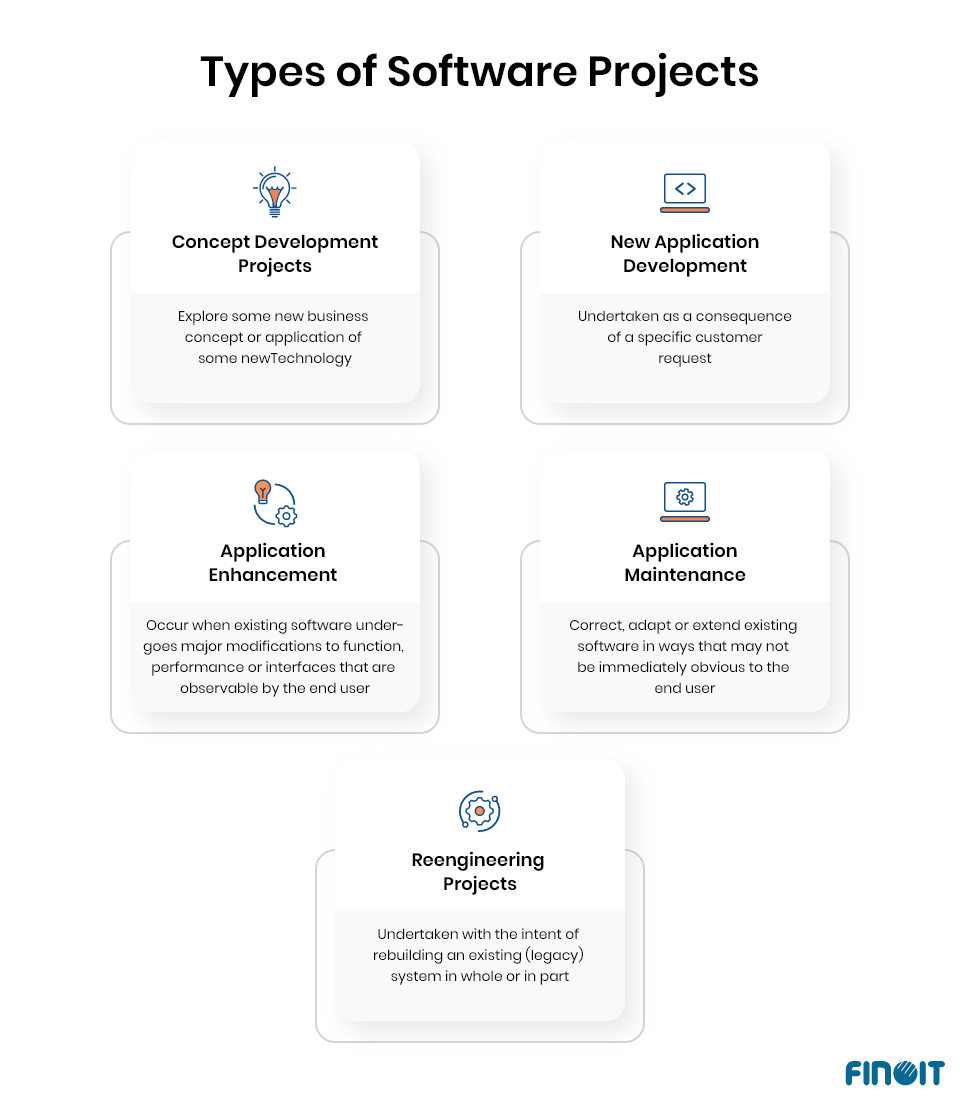
Software Development – Technology and Use-cases
Modern software is laced with new technologies to make them more effective for users. These technologies are the highlight of the software, namely:
AI based Software
Artificial Intelligence (AI) is the simulation of human intelligence processes such as reconnecting to past experiences and finding patterns to arrive at a decision or make recommendations. AI based software applications replicate the human intelligence processes to apply knowledge and find solutions autonomously. For example, AI-powered assistants, autonomous vehicles, facial recognition tools, industrial robots, and more.
How Does an AI Application Work?
Artificial Intelligence Software is a combination of tools and techniques such as training machine learning algorithms, image recognition tools, natural language processing, neural networks, and various other specialized hardware and software applications.
These tools and techniques allow the software to process a large amount of data for finding correlations, spotting anomalies, and determining patterns. High quality data and powerful machine learning algorithms allow the AI based applications to use these 3 major cognitive skills:
- Learning: This aspect of AI programming focuses on the use of data and algorithms to emulate the human learning process in order to improve the accuracy of their predictions and recommendations.
- Reasoning: The segment deals with helping AI application to choose the right algorithm to perform a certain task.
- Self-Correction: It is a continual process to fine-tune algorithms to deliver accurate results.
AI-based software applications are used in various industries to perform detail-oriented, repetitive tasks to reduce the administrative workload, generate insight to improve on decision-making, and predict behavior and patterns to make recommendations.
| Learning | Reasoning | Self-Correction |
|---|---|---|
| Emulates the human learning process in order to improve the accuracy of their predictions and recommendations. | Helps AI application in choosing the right algorithm to perform a certain task. | A continual process that fine-tunes algorithms so that they can deliver accurate results. |
An example of AI-driven Software application:

IoT Application Development
IoT application development is the process of building software applications that transform data acquired from machines into valuable information. The application processes the data collected through the sensors over cloud to generate insight. This insight helps product owners learn to manage the product more effectively and ensure their optimal utilization.
How Does IoT Work?
The IoT ecosystem consists of three major components:
Connected devices: These devices span over anything from medical devices to agriculture equipment, and automobiles to consumer electronics. Connected devices come with unique identifiers (UIDs), embedded systems such as sensors, processors, and communication hardware along with the ability to transfer data over a network without human interventions.
IoT Gateway: IoT gateway is a hardware or computer program that links connected devices to the Cloud or other data analytics systems. It allows bi-directional data flow between the connected devices and the cloud. The main role of an IoT gateway is to facilitate inter-device communication, device-to-cloud communications, data preprocessing, IoT device security, and Intelligent Edge.
Data System: This aspect of the IoT focuses on collecting, refining, and organizing data to get information out of them. The process begins with storing data to a centralized location and covers policies, practices, and procedures for full cycle data management, ensuring agility, security, and scalability.
IoT application development is about building applications that capture and manage the flow of data, from devices to applications via various types of IoT sensors and vice versa to keep the organizations and product owners informed, and the role of IoT application development companies is to collect that data seamlessly and generate insights that create value.
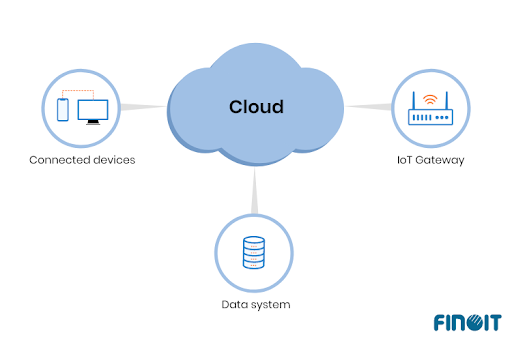
Blockchain Development
According to IBM, “Blockchain is a shared, immutable ledger” that enables users to record transactions and track the history of assets and transactions in the business network.
It covers both tangible and intangible assets varying from car, house, and cash to intellectual property rights, patents, copyrights, branding, etc. The fundamental components of blockchain technology are:
- Distributed ledger: The access to the ledger is available to everyone in the network. Transactions in the ledger could be recorded only once, thus eliminating the chances of duplicate entries.
- Immutable records: Blockchain uses cryptography which makes it extremely difficult to change or tamper with the record. In case of errors in a record, a new record can be added and both transactions would be visible to the participants.
- Smart contracts: It is a set of rules and conditions stored on blockchain, applied on corporate bond transfer, including terms for insurance and more. Smart contracts are automatically verified and executed through a computer network.
How Does Blockchain Work?
Transactions are recorded in the blockchain as a “block” of data. The data block represents an asset and could have any information required, including all the aspects of who, what, when, where, and how.
Each block of data is connected to the last and the next transaction, thus forming a chain of data in the proper sequence of transactions. No new blocks can be created in between the chain, and neither any information in the block could be altered by any participants, creating a highly trusted environment.
Blockchain is not a general purpose solution. It is only recommended when there are multiple participants having trust and integrity issues between them, when the order of transactions matters, or when the business logic is static, along with a few other scenarios.

Cloud Native Development
Cloud native development refers to the concept of building applications in a cloud environment, using the benefits of distributed computing, including technologies such as Kubernetes, serverless functions, Docker, Kafka, and APIs. The development allows software developers to use reusable components called microservices, packed in containers, to reduce operational tasks, speed up development, and improve extensibility.
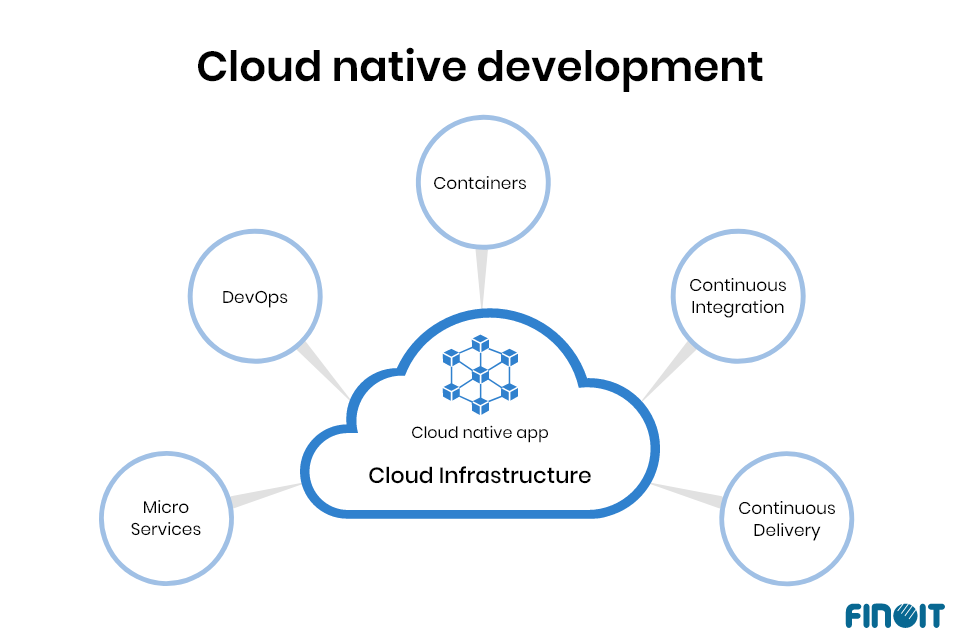
Cloud-based Software Development
Cloud-based development enables software development teams to build applications in cloud-based environments supported by Platform as a Service (PaaS) platforms or integrated development environments (IDE). Most agencies today use cloud extensively and provided cloud-based development services.
Cloud-based environments support all the functions of software development and also provide access to an assortment of software development tools, APIs, microservices, and DevOps.
Low Code Development
Low code platforms create a visual software development environment, allowing the developers to drag and drop components of software and piece them together to build mobile or web applications. It enables companies with small IT teams or developers with not that much experience or knowledge to build reliable applications with ease.
In addition to improving the affordability of building applications, web application development companies can help build platforms for low code development, reducing the need for extensive coding.
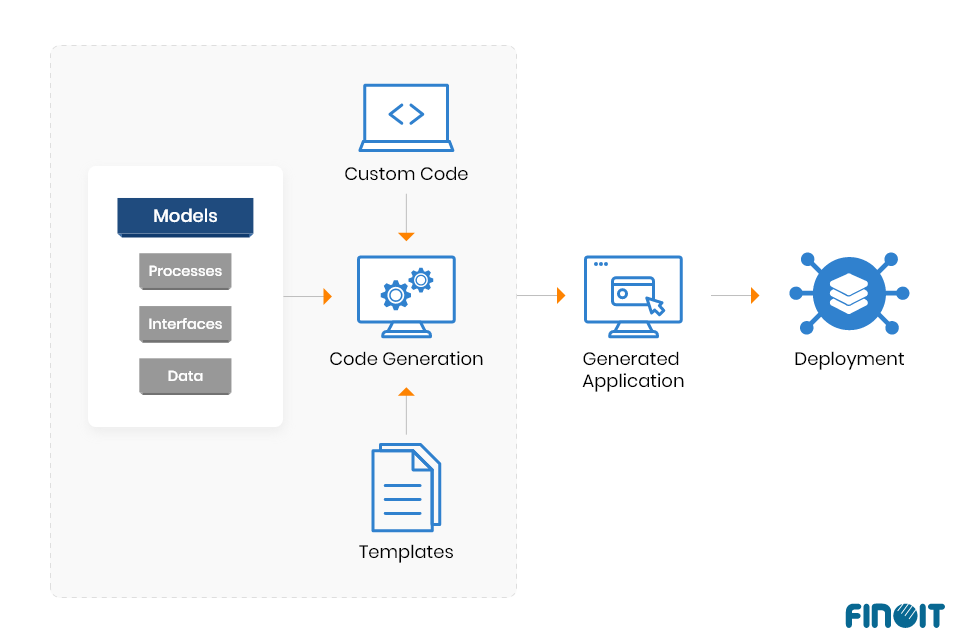
No Code Development
No code development addresses the need of business users to participate and contribute to the software development process, without gaining programming skills. The intended benefit of no code development is to bring in the expertise of business users to improve the user experience of the application.
Mobile App Development
Mobile application development is the process of building applications for small, portable devices like smartphones, tablets, and other hand-held devices. While it is a part of traditional software development, an important difference is that mobile applications are device specific.
Mobile application development companies have expertise in dealing with the aspects of a mobile devices that impact coding and UI design like the operating system, screen size, and computing capabilities.
There are two OS that dominate the industry and are used for app development- an Android app development company will use associated technologies to build apps running on Android OS while an iPhone app development company would use iOS OS
Data Analytics Tools
Modern software solutions are integrated with sophisticated analytical capabilities. These capabilities are built upon Cloud-based solutions and APIs that enable data exploration, automate predictive analytics, and build dashboards to aggregate and visualize data from various sources such as databases, locally hosted files, and web services.
Model Based System Engineering (MBSE)
According to INCOSE, “ Model based system engineering is an application of modeling to support requirements, design, analysis, verification and validation activities”, before the beginning of actual design. The analysis supports better requirement evaluation and accelerates from design to implementation.
These features in software applications basically determine the kind of tools the software developers and programmers would need to build the application.
Software Development Tools
Software development tools are computer programs that software developers use to build, test, debug, manage, and maintain software applications. However, since software development is not only about programming, and managing tasks, applying modern-age principles like DevOps is an integral part of the journey, there are several other types of tools that are used to manage the overall project.
A list of key categories of tools used in the software development process is:
Programming Tools
Programming tools enable software developers to write computer programs in programming languages such as Java, C+, C#, Python, Golang, etc. that translate a program from a human readable and writable source language into bits and bytes to be executed by computers.
Some of the commonly used programming tools are source code editors, compilers, interpreters, debuggers, disassemblers, GUI interface generators, and revision control.
The features of these tools are combined into one package, called IDE, also known as Integrated Development Environment. IDEs are mainly used for enterprise-level software development.
Project Management Tools
Software development project management tools are computer programs that are used to organize and manage tasks associated with software development projects. Tools for project management in software development are used for planning, scheduling, communicating, collaborating, documentation, and evaluation functions.
One of the most common project management software is JIRA which is built upon the agile SDLC principle. It is one of the best project management tools for software development. Jira consists of flexible work views, resource management tools, dashboards, reporting, Gantt charts, and timesheets to increase transparency and efficiency in the project. Asana, Smartsheet, and ProofHub are some of the known agile software development project management tools.
What to look for in project management software?
Selecting project management software has emerged as a challenge for project managers as there are multiple tools. Here are key criteria for selecting project management software.
- Budget: How much the project team is willing to spend on procuring the project management software?
- Collaboration Support: How many users are supported? To what extent the application can be scaled?
- Storage: What is the per-user storage capacity that the software offers?
- Permission Management: How strong are permission protocols?
- Integration: How easily can the tool integrate with other applications?
When project management software selection is based on these criteria, project teams can shortlist from the available options and easily identify the best project management software for software development.
DevOps
DevOps refers to the concept of aligning software developers (Dev) and software development operations (Ops). The alignment focuses on accelerating the speed, efficiency, and security of the software application through a culture of collaboration, effective communication, and shared responsibility.
The need for DevOps is driven by enterprises moving to microservices architectures and increased use of tools across the software development process. DevOps aims at creating the right project-tool integration to automate the software development lifecycle.
GitLab is one of the widely used DevOps tools. It is a software package that combines the ability to build, deploy, and maintain the software in a single application. A few other popular DevOps tools include eggplant, SolarWinds, Jenkins, and Prometheus.
Software development tools are used at various steps involved in the software development process and DevSecOps (Devops security) also has started gaining prominence now a days and has become an integral part of the process.
DevOps – A basic working framework
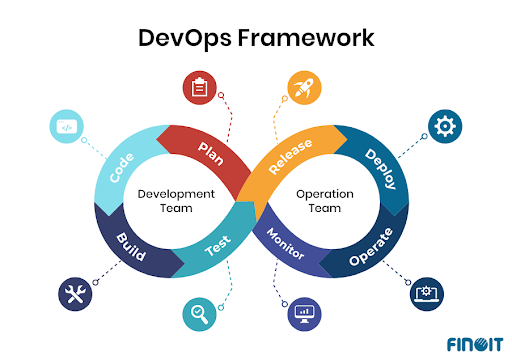
Infographic highlighting how DevOps brings transformation to the application development process.
Step-by-step Software Development Process
A software development process is a pipeline of different stages that are followed to build a usable software product. The process is given direction by the chosen software development methodology.
Different types of software development methodology in software development are there. These methodologies are based on different software development models. Today, agile approach is widely used, since it combines positive features of different software development process models and offers an iterative framework to develop software.
Below, we throw more light on software development methodologies and stages of software development.
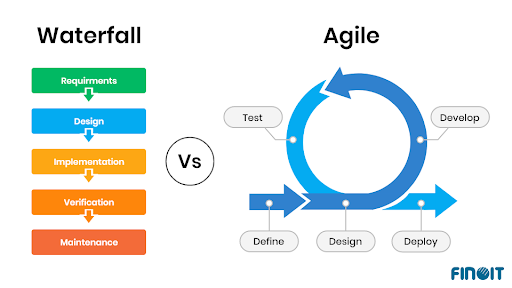
Software Development Methodologies
A software development methodology is a comprehensive framework to organize, assess, and control the software development tasks. Popular software development methodologies are agile, waterfall, DevOps, rapid application development (RAD), feature-driven development, lean development, and extreme programming.
However, all these methodologies are bound to the software development lifecycle, although the emphasis on structures, modules, and features, flexibility of time and cost, and flow of the information in SDLC stages may differ from one methodology to another. Additionally, the choice is also affected by the envisioned software project goals.
Modern software development methodologies ensure value generation during each phase of the life cycle as the following infographics illustrate.
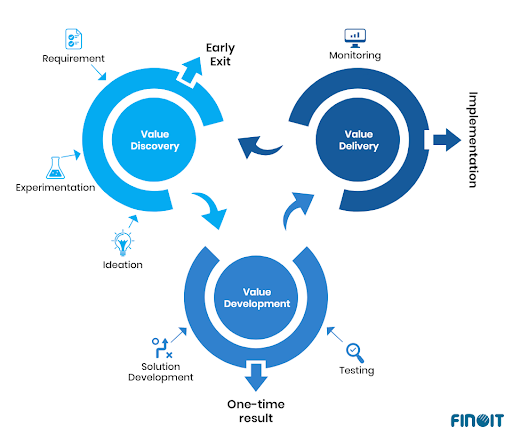
Stages of Software Development Lifecycle (SDLC)
Software development lifecycle (SDLC) is a standard procedure of software development. The steps prescribed in SDLC are practiced in a definite order, in a series of stages, where all the tasks specified in each stage must be successfully completed, before moving to the next stage.
Software development life cycle models have undergone many transformations, reaching very advanced forms. Today, identifying the best methods of software development for your project is a separate activity, coming under the purview of project managers.
In general, the stages of the software development lifecycle are:
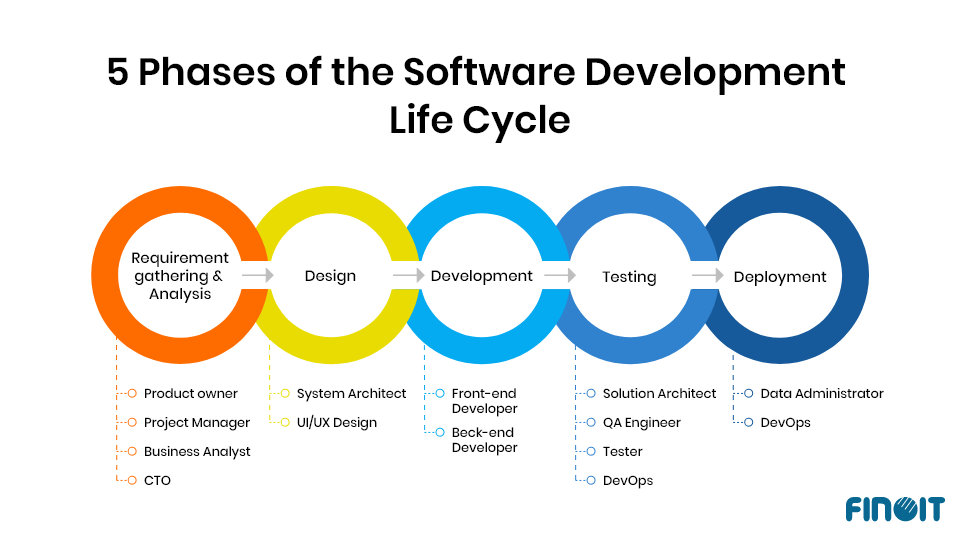
Requirement Gathering and Analysis
Requirement gathering in software development is the process of identifying and examining the need of software from user perspectives. It includes a detailed study of the problem and finding out the steps for resolution.
Key components of software requirement gathering and analysis are:
Idea Validation
Software idea validation is the process of confirming that the software does achieve its intended objective. For example, it solves the problem, provides the expected user experience, has a market demand, or generates a willingness among the users to pay for the software. The approach to validation may include experimentation, survey, sampling, and interviews.
MVP in software development is a common approach to validate the software idea. According to IBM, MVP is “the smallest possible version of a product that can be used to run a meaningful experiment to test key hypotheses and determine whether to continue investment.” Here is a detailed guide on how to approach MVP in software development that you may find helpful.
Feasibility Study
Software feasibility study is performed to check the viability of the software from operational, technical, economic, and organizational points of view. The outcome of the study must demonstrate whether the software project is capable of attaining its objectives or not.
Project Estimation
Software project estimation is the process of predicting the cost, time, and resources required to complete the project. Project estimation provides a deeper view into software size, primary and secondary functions of the software, efforts required to complete the tasks, and the cost of the resources.
Team
Team is one of the most critical resources in software development. Building a self-organizing and cross-functional team of technical and non-technical members is hard. And much harder is keeping everyone on the same page. It is important that the right team culture, focused on domain knowledge and accountability, is built from the start.
Design
Software design is a process of creating a framework that presents a roadmap, constraints, and specifications essential for the software to achieve its intended goal.
Software design focuses on planning, conceptualization, and assessment of components, including operating systems, architecture, modules, hierarchical input and output, data flow, relationship models, and cloud computing paradigms to be implemented in the software.
The proposed software design is then broken into small parts to be forwarded for coding.
Development
Coding
At the development stage of SDLC, code is written to implement the design. Software developers follow the coding guidelines such as syntax and programming style of the programming language and use software development tools to write and implement the code.
Code is written on standalone code editors such as Visual Studio Code, Espresso, Atom, etc. or IDEs like Eclipse, PyCharm, or NetBeans, which are selected depending on the programming language, operating system, features, and price or IDEs which have full functionalities to write, compile and debug the code.
Database Development
Database development is a method of creating a logical structure of how the data will be stored and retrieved. A critical consideration is the intended use of data, based on which roles, permissions, authentication, and verifications processes are planned and developed within the software.
Testing
Quality is the most crucial metric for gauging the success of a software development project. Indeed, quality assurance in software development can turn success into failure, as merely having a team of good developers won’t do the job.
Testing is a part of any product development. Like in the automobile industry, vehicles are tested before final delivery. Software development is no exception to this. Testing in software development is performed post code compilation. As soon as the code is compiled, it has to go through the process of testing. Testing is done to validate the software in a strategic and documented manner. Software testing includes a sequence of tasks to ensure that software is defect-free and achieves its intended goal, without compromising on quality and security.
The effectiveness of a testing process is governed by many factors. The foremost amongst these is the quality control plan for software development. In high quality software development projects, quality standards are adhered to right from the beginning phase.
Types of software testing
QA in software development comprises a variety of testing procedures. Here, we discuss the top 10 types of software testing and their major focus area:
- Unit testing: Test on small sample input and analyze the corresponding output.
- Integration testing: In this type of software testing, a group of components is combined to produce output
- Regression testing: Test is performed to check any abnormal or unusual behavior when a new module is added to the software.
- Smoke testing: Helps check the stability of the software
- Alpha testing: A type of testing done before the release of the product to real-world users
- System testing: Tests performed to check the compliance of the software with the corresponding requirements.
- Stress testing: This type of testing is conducted to validate the stability of the system in context with software.
- Performance testing: It is non-functional testing performed to evaluate the stability, speed, scalability, and responsiveness of the software.
- Object-oriented testing: It is a process of testing the software on object-oriented paradigms such as inheritance and encapsulation.
- Acceptance testing: This is the last stage of software testing, done to determine whether the software fulfills the business and customer requirements.
These tests are performed either manually or using automated tools. While manual tests are performed in a series of steps, without test scripts, automated testing is done through test automation frameworks, tools, and other software applications in a sandbox environment.
Deployment
Deployment occurs in 3 phases.
The first phase is Deployment itself of which top considerations are:
- Setting up servers: It is a series of processes, starting with server hardware and operating systems selection. An important factor that impacts server selection is the location of the server as it is critical to business continuity during disruption.
- Building a CI/CD pipeline: It is a practice of enforcing automation in the SDLC process to optimize software delivery.
The second phase is about maintenance and operations, which include:
- Penetration testing: The testing is done to find vulnerabilities in the software and network systems before they become incidents.
- Optimization: Based on the outcome of the penetration testing and key user preferences, software application maintenance and support services work such as updates, fixes, modifications, and replacements could be planned on major or minor levels.
The third phase is security, which deals with:
- Monitoring: It includes creating an end-to-end monitoring and surveillance program to ensure safety and security to prevent data breaches and keep the privacy and confidentiality of the information.
Hiring software development developers and companies
The extensive magnitude of software development forces many organizations to outsource their software development projects. Whether you are hiring software developers or an agency, screening, and vetting thoroughly is the first step in the process to enter into a partnership. A reputed software development company develops a holistic understanding of client understanding and builds clear quality goals.
Software development is the method of transforming an idea into a functional product. It may not be necessary that someone with an idea to have the technical skills and resources to build the product. This brings software dev vendors into the picture, who provide a range of software development services and help you build products that one has envisioned.
When businesses embark on the journey to outsource software development, they are stalled first by the most common question i.e., how do choose the best provider for you? Well, as said, choosing a provider is a mighty task, and businesses must first develop a selection and screening framework to identify the best software development agencies.
Many businesses now look to hire remote software developers while outsourcing software development. There is no dearth of software development service providers in the market, which calls for a cautious selection of the right company for the successful completion of the project.
How to screen and select the best software agencies for your project
There are several criteria for proper screening and selection of the software agency for the project. Some of the key criteria include the type of the software development project, time to market, location—nearshore, offshore, or onshore, reviews and quality of references, and background of successfully completing the project.
How to choose a software team
Here is a snapshot of the approach that businesses must follow while choosing a software company:
- Drive thorough research using various resources – Go through websites, examine standing on listings, understand financial standing of the companies.
- Go through the use cases addressed by the company and evaluate competency fit.
- Check social media handles for client feedback and develop an understanding of the company.
- Consider factors such as years of experience and team expertise; pay attention to technical factors such as frameworks, tools, and infrastructure.
- Avail first-free consultations for pilot implementations and draw comparisons between shortlisted software development partners.
What to look for in your development company
A prospective software development partner would be one that has:
- Developed software applications for a similar project
- Deployed solutions across industry domains
- A versatile software development team
- The ability to scale with ease
- Achieved recognition in form of awards, certifications, rankings, etc.
- A framework that delivers quality applications at an optimized cost
Top 10 software development companies that provide quality software development services
Listing top 10 software development services providers is a gigantic task, as it requires comprehensive research in areas such as the ability to manage project size, financial stability, team handling, pricing, and support services for an unbiased outlook.
Besides, it is important that a list of software development companies is prepared with these factors in mind: audience, objective, context, clarity, and availability.
There are specialized software development services for startups. These are the companies that provide custom software development for startups. While there are software development companies that deliver services specifically to SMBs and Mid-market. Based on our research, here we have compiled lists for both.
Here is a list of top software development companies for startups:
Business models of most startups these days are technology-heavy. Software development for startups has thus emerged as a discipline within software development. Here are some known software development companies for startups.
And here is a list of top software development companies for SMBs and Mid-market
There are many software companies that claim to be the best small business software development services. Listed here are top software development companies for custom software development:
In-house Development or Outsourcing
In-house development is a costly deal as businesses have to self-drive the hiring actions and invest in building a robust technological infrastructure. Building this ecosystem is a time-consuming process.
On the other hand, when outsourcing using an offshore software development company, businesses are freed up from this cumbersome process. Most times, this not only results in cost competitiveness but also reduces time-to-market because they are able to hire more developers at the same or lower costs. Here is a detailed post on how to reduce software development cost that you may find useful.
Erstwhile claims that scalability and better team control are possible only with in-house teams no more holds right. Today, software development partners help you build custom teams with whom you can choose to work as per the project’s requirements.
Anyway, there are advantages and disadvantages of in-house software development and outsourcing too. Businesses need to consider several factors, including hourly software development rate and team size requirements to make a decision.
Software development staff augmentation is another area that comes within the outsourcing model. When businesses don’t have enough resources they can reinforce their in-house teams by collaborating with a good development partner.
Across the world, Asia offers the lowest average hourly rate for software development. India has emerged as a favorite outsourcing destination for businesses operating in North America, South America, Europe, and Australia. The availability of the best software development talent at the lowest cost coupled with time zone advantages makes software development companies from India an apt choice to partner with.
Best engagement and pricing models to hire software developers and agencies
The software development engagement and pricing model is a plan that sets the ground rules of engagement between the development service provider and the project owner. It describes the way teams of both parties would engage with each other to complete the project. Information that finds a place in the description is project management roles and authorities, key users, meetings, milestones, terms of payment, timelines, and methods to resolve management issues.
What engagement model is best for software project development is purely a contextual question to address as there are multiple engagement models in software development. The project owner will have to sift through the details of each model before choosing the one. Here, we offer a basic understanding of how you can choose an engagement model.
How to choose engagement models in software development project
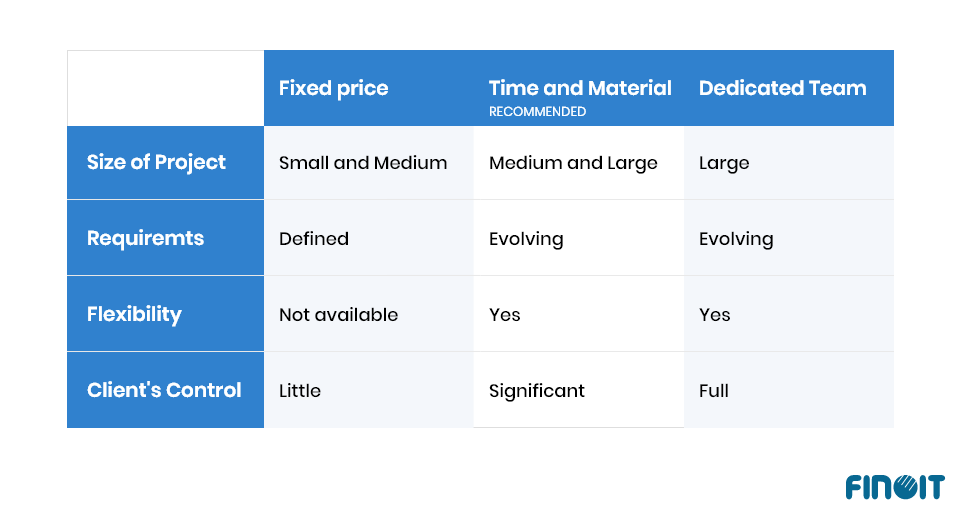
Top Characteristics of a Software Quality- what makes a software good?
A good software is functional, reliable, and reusable. As we discussed, it is QA in software development that imbibes these features into the application. We can also judge the software quality standard across three dimensions viz. operational, transitional, and maintenance. Here we discuss how the quality of the software can be measured on these metrics:
- Operational: Operational factors emphasize on the profitability and sustainability of the software from business standpoints. Operational metrics are budget, dependability, security, development time, number of functionalities, security, and so on.
- Transitional: Transitional metrics are the indicators of software’s capability to function in an ecosystem. Factors that indicate the transitional quality of the software are adaptability, interoperability, reusability, etc.
- Maintenance: It covers metrics that indicate the software’s ability to transform with the new requirements. Indicative maintenance factors are scalability, modularity, maintainability, and more.
Overall, a good software fulfills the business objectives and user requirements.
Best programming languages for software development
While there are options to choose from the top programming languages for software development, there is no standard available to classify a programming language as the “best.” The best programming language for one business may not be the best for another, because software operates in an ecosystem. And a programming language for software development projects is selected based on that existing ecosystem, whether it is for enterprise or for commercial purpose.
Generally, programming languages are selected for font-end and backend software development projects.
Best programming languages for back-end(server-side) software development
Back-end software development, also known as server-side programming, has several considerations before selecting a programming language. The back-end consists of a server, an application, and a database. When selecting a programming language, back-end components and operating systems that together form a tech stack is carefully analyzed in the best interest of the project.
Usually, back-end programming languages are categorized into two parts, which represent how data is stored:
- Object-oriented programming: In this type of programming language, objects are mutable and manipulated through functions. The most common examples of OOP are Java, PHP, and Python.
- Functional programming: This type of programming language does not allow change in the state of stored data. It means higher predictability as the function always provides the same output for an input. A few examples of functional programming are: R, SQL, and Haskell.
Programming language selection is usually tech-stack specific, wherein the most common tech stacks are LAMP, MEAN, MERN, MEVN, ASP.NET, and others.
Best programming languages for front-end software development
Front-end development deals with the visual elements of the software. Common programming languages used for front-end development are HTML, CSS, JavaScript, and JQuery.
Software development- Future trends
The software world is expected to see next-generation technologies in full swing, from one end of the spectrum to another. Typically saying, it would span almost all industries, including software development as well.
Major developments are expected in coding areas where AI and ML will reduce the dependency on software developers by applying recommendations-based coding, making it an easy and fast process. Automated testing and code reviews are already replacing manual testing. Kubernetes, cloud-native technologies, and blockchain will dominate the software development process.
Software development top trends would also feature the widespread use of Narrow Artificial Intelligence, advancing DevOps tools, and multimodal and multipurpose databases.
Security in Software Development- Best Practices
Building secure software and maintaining its security are two different things and still, most developers and agencies tend to miss out on it. Software security must be introduced at the planning phase in the form of a clear and guided software development policy, containing detailed instructions on practices, processes, and tools for addressing the vulnerabilities and mitigating the risks.
One of the major hindrances to software security is the mindset. At Finoit, we have seen that a developer either has that mindset or not, and most times, it needs strong SOPs and practices to build the right mindset to ensure product security.
Also, software security is often treated as an added cost and dealt with an incident-oriented approach. It should rather be a proactive process, managed with a comprehensive, continuous, and constantly-changing outlook.


